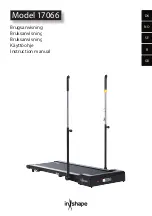
15
HOW TO USE THE MANUAL MODE
Insert the key into the console.
See HOW TO TURN ON THE POWER on page
13.
Personalize console settings if desired.
See HOW TO PERSONALIZE CONSOLE SET-
TINGS on page 13.
Select the manual mode.
Each time the key is inserted, the manual mode
will be selected. If you have selected a program,
press any of the program buttons repeatedly until
the word MANUAL appears in the display. Note:
Make sure that an iFIT card is not inserted into the
iFIT slot.
Start the walking belt and adjust the speed.
To start the walking belt, press the Start button,
the Speed increase button next to the Start but-
ton, or one of the numbered Quick Speed buttons.
If the Start button or the Speed increase button is
pressed, the walking belt will begin to move at 2
Km/H. As you exercise, change the speed of the
walking belt as desired by pressing the Speed in-
crease and decrease buttons next to the Start but-
ton. Each time a button is pressed, the speed set-
ting will change by 0.1 Km/H; if a button is held
down, the speed setting will change in increments
of 0.5 Km/H. If one of the numbered Quick Speed
buttons is pressed, the walking belt will gradually
increase in speed until it reaches the selected
speed setting.
To stop the walking belt, press the Stop button. To
restart the walking belt, press the Start button, the
Speed increase button, or one of the numbered
Quick Speed buttons.
Change the incline of the treadmill as desired.
To change the incline of the treadmill, press the
Incline increase and decrease buttons or one of
the numbered Quick Incline buttons. Each time
one of the buttons is pressed, the incline will grad-
ually increase until it reaches the selected incline
setting.
Select a display mode and monitor your
progress with the display and the intensity
level bar.
As you walk or run on the treadmill, the display
can show the following workout information:
•
The elapsed time.
•
The distance that you have walked or run.
•
The speed of the walking belt.
•
The incline level of the treadmill.
•
The approximate number of calories you have
burned.
•
Your walking or running pace, in minutes per
mile or minutes per kilometer.
•
A visual equalizer.
•
Your heart rate. Note: Your heart rate can be
displayed only while you use the handgrip
pulse sensor or the chest pulse sensor.
•
In addition, the display can show a “workout
history”—a profile that represents the speed
settings that you select during your workout. At
the beginning of each minute of your workout,
an additional column will appear in the profile;
as you increase or decrease the speed setting,
the height of the column will increase or de-
crease.
•
The display can also show an animation of a
runner on a road. As you increase or decrease
the speed setting, the runner will speed up or
slow down.
6
5
4
3
2
1














































